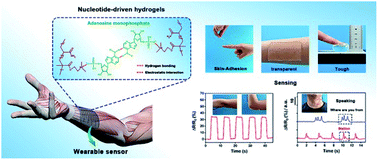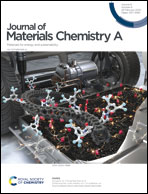Nucleotide-driven skin-attachable hydrogels toward visual human–machine interfaces†
Abstract
Great progress has been recently made in flexible and stretchable electronics. However, realizing the conformal contact between sensors and human skin as well as the visualization of human–machine interfaces is still a challenging task. Here, self-adhesive hydrogels with high transparency are successfully fabricated by a facile one-pot radical polymerization of acrylamide (AAm) and 2-(dimethylamino)ethyl methacrylate (DMAEMA) in the presence of adenosine monophosphate (AMP) as a model nucleotide. The addition of a nucleotide makes the hydrogels promising conductors with robust adhesiveness, excellent mechanical behavior, and high optical transparency (transmittance of 94%). Remarkably, the hydrogels can conformally adhere to human skin and adapt its dynamic motions, which can work as skin-attachable wearable strain sensors for accurately monitoring human joint motions, breathing and voice signals. And the hydrogels are capable of perceiving pressure variations for the detection of human movement states, including walking, jogging, and jumping. Besides, the hydrogels featuring high transparency allow creating visual human–machine interfaces for clearly observing the skin condition in real time. This work proposes an innovative and facile strategy for the design of promising soft materials for sophisticated human–machine interfaces.



 Please wait while we load your content...
Please wait while we load your content...